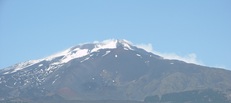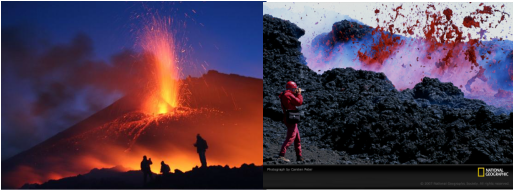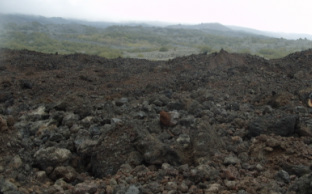|
Today is the turn of Mt. Etna. Having recently visited Etna this post may be a little longer than the others so I apologize! A recent Daily Volcano Quote by the Volcanism Blog, available here summarises Etna extremely well! I have previously posted on etna in the following posts on lava stalactites, xenoliths, Rifugio Sapienza and a view of the composite cone. You can view all of these by clicking on the category for Etna along my sidebar. Etna is a stratovolcano which has been built onto an older shield volcano. The entire volcanic complex is ~ 500,000 years old. The reason for its location is complex and there are many theories but it is generally belived that it's location is down to the extension of the crust because of the reversal of the Ionian slab. The first edifice started forming ~180,000 years ago and is built up of a large number of pyroclastics and lavas. The last 14,000 years of edifice formation is referred to as the Recent Mongibello, which is also the name of the current summit crater (Mongibello). Etna is characterised by smaller explosive eruptions such as Hawaiian and Strombolian activity accompanied by lava flows which occur both from the summit craters and eccentrically (on the flanks of the volcano). More rarely Etna has seen basaltic plinian eruptions in 122 B.C. and 44 B.C. Baslatic plinian eruptions are rare themselves.The lavas which are generated at Etna tend to be either ʻaʻā or pahoehoe in nature. Pahoehoe is the lava which is commonly seen on Hawaii, it is runny and less viscous. ʻAʻā is more viscous and is generally characterised by a more blocky morphology. Etna experiences regular outbursts of activity the most recent occuring within recent months. Tomorrow is the turn of Galeras, Colombia. The following are a couple of interesting articles on Etna. For more general information see the global volcanism program. Thanks for reading!
Gillot, P.Y et al. 1994. The evolution of Mount Etna in the light of potassium-argon dating. Acta Vulcanol. 5, pp. 81-87 Guest, J.E et al. 1984. The valle del bove, Mount Etna: Its origin and relation to the stratigraphy and structure of the volcano. Journal of Volcanology and Geothermal Research 21 (1-2), pp. 1-23 Monaco, C et al. 2005. Tectonic control on the eruptive dynamics at Mt. Etna Volcano (Sicily) during the 2001 and 2002-2003 eruptions. Journal of Volcanology and Geothermal Research 144, pp. 211-233
Joy Poortier
12/6/2011 10:32:49 am
I would love to know if Eruptions that shook the earth is on video. If so could you let me know so I can see if I can obtain it. I would love to have it in my collection. I osunds amazing.
Volcano Blog (Tom)
12/6/2011 10:59:05 am
Joy, I am afraid not, its only in book format, am just about to start reading it. If your interested in dvd shows etc there are a couple presented by Iain Stewart of Plymouth University - Earth: The Power of the Planet and How Earth Made Us. There is also a good (and slightly cheesy) docudrama called supervolcano which was produced by the BBC. Hope this helps, Tom from Volcano Blog. Comments are closed.
|
Archives
July 2023
|




 RSS Feed
RSS Feed